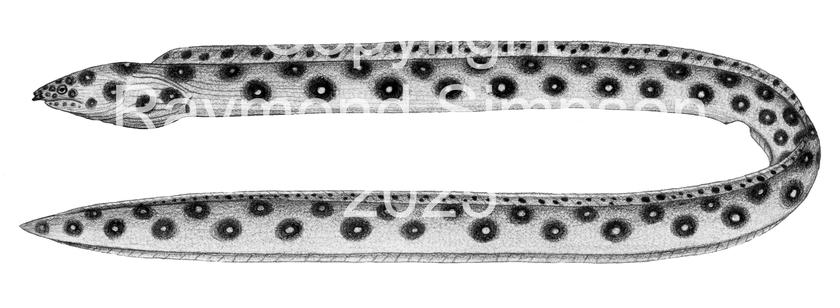
Common Name
Goldspotted Eel
Year Described
Lesueur, 1825
Identification
Vertebrae: 164-174 (57-61 pre-anal)
Body elongate and cylindrical (compressed on end of tail). Trunk shorter than tail (37-42% TL). Snout short and broad, downturned and overhangs mouth. Eye over middle of jaw. Underside of snout with a toothed notch reaching between anterior nostrils. Jaws short. Anterior nostril a well developed long tube with an irregular fringe. Posterior nostril opens into mouth. Teeth molariform. Teeth in multiple rows in both jaws. Intermaxillary teeth present. Vomer with one row of teeth. Gill openings semicircular, vertical and close together. Dorsal fin origin before gill opening. Anal fin present. Pectoral fin small and rounded. Caudal fin absent. Tail tip hard and pointed. Lateral line complete. Head pores well developed. Preopercular pores 2.
Color
Body gray grading to whitish on the belly. Body and head with large, round, diffuse black ocelli with bright yellow centers. Spots on snout are smaller in size but the same coloration. Dorsal fin gray with black spots and white edge. Eye whitish.
Size
Maximum size to 110cm TL.
Habitat
Found on sandy bottoms, seagrass beds, and coral reefs from 0-150m, but usually <10m. Species in this genus much more likely to free swim than others in the family and mistaken for sea snakes.
Range
North Carolina to S. Brazil, including Bermuda, the Gulf of Mexico, and Caribbean Sea.
References
Böhlke, E. B. (ed.). 1989. Volume One: Orders Anguilliformes and Saccopharyngiformes. Volume Two: Leptocephali. Fishes of the western North Atlantic. Memoirs of the Sears Foundation of Marine Research Mem. 1 (part 9): v. 1:i-xvii + 1-655; 2:i-vii + 657-1055.
Other Notes
Myrichthys oculatus is a synonym. The relationship of this species with the E. Atlantic M. pardalis needs further study as they share a similar color pattern and differ only slightly in vertebral counts.